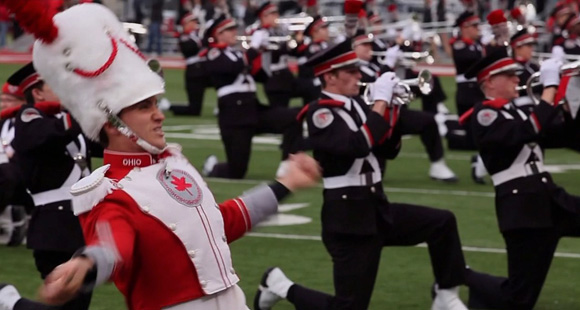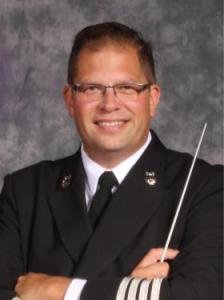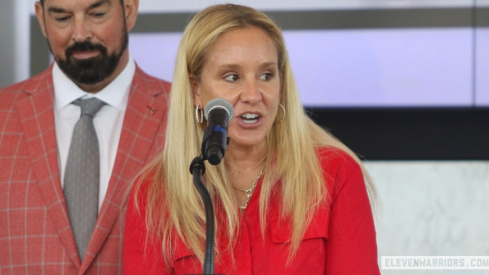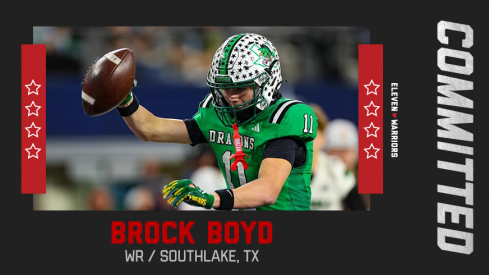2026 four-star wide receiver Brock Boyd flips his commitment from TCU to Ohio State.

Ohio State has long had an acrimonious relationship with the Southeastern Conference. On the football field, the SEC has made a habit out of defeating the Buckeyes and, in some cases, embarrassing them. Tennessee and Kentucky added to the frustration on the hardwood, when the two schools bounced Ohio State from the NCAA Tournament in years that offered high hopes. Aside from Michigan, no one is more hated in Columbus than the SEC.
The competition is even entering band circles now. SEC bands have traveled extensively through the years, often attending every football game in a season. The Ohio State University Marching Band will soon be joining that list, thanks to a new source of funding.
Gordon Gee, Gene Smith and the powers that be at Ohio State got together and determined that the College of Arts and Sciences and athletic department would continue financing the band. But one key change would be the addition of the Development Office of the President. Instead of a miniscule $220,000 operating budget – ninth in the Big Ten – the Buckeyes will have $1 million, which vaults them to first. With it comes more travel.
The band will attend road games at California, Purdue, Illinois and Michigan. The Cal trip will include a performance in Los Angeles, a drive up the California coast and stops at Pixar Studios and Skywalker Ranch, home of Star Wars creator George Lucas. The journey to Pixar will be a reunion for some employees, as the film company has roots at Ohio State and is known to employ OSU graduates.
“The university has taken on a wonderful new opportunity for the band to be funded by the Arts and Sciences College, the athletic department and the President’s Office,” said marching band director Jon Waters. “Those three areas are providing a significant increase in our funding and reducing our students’ costs. Before this season, students had to dry clean their own uniforms and even buy their own Gatorade at games. What this does is allow us to provide everything to our students for free.”
The image of band members having to clean their own uniforms doesn’t jive in an era where athletes seem to get preferential treatment at every turn. But the days of going without a dry-cleaned uniform are over for Ohio State’s band members.
Prior to the recent funding increase, 65-70 percent of the band’s annual expenditures were through private donations, Waters said. Gee has been one of the band’s most ardent supporters, dating back to his first stint as president. He demonstrated that emphatically by approving the change.
When Michigan’s band traveled to the Cowboys Classic in Dallas last season for the Wolverines’ game with Alabama, it cost the university an estimated $400,000. The decision to send the band came after heavy criticism when it was announced they would not make the trip. Less than a year later, it appears two of the nation’s premier marching bands have earned a spot near the top of their university’s hierarchy.
“We are entering a new era in the Ohio State Marching Band, and certainly with our football team, it’s really exciting.”
“The driving force (for the funding) was out of necessity and a desire by the university to reduce the costs individually,” Waters said. “We are entering a new era in the Ohio State Marching Band, and certainly with our football team, it’s really exciting. The energy on campus is palpable. The spark is there. People are already counting down the days till kickoff. The impetus that really drove this was a renewed energy behind the band and the football team, and the ability for our university to step forth and recognize the band for the great things we have done.”
Being a student-athlete at a Division I school is akin to having a full-time job. It’s something that over the time the public has become aware of. But many would be surprised to learn the same thing about marching band members. School and practice time accumulates rapidly. And unlike athletes, trumpet and sousaphone players don’t receive a full scholarship.
That’s why Waters was in Holland, Ohio, outside Toledo, on Monday raising money. He took part in the inaugural Cheryl Jacobs Waters TBDBITL Golf Invitational, a fundraiser to help raise scholarships for the band. The event, named in honor of Waters’ late mother, drew a large crowd of scarlet-and-gray-clad hackers.
Reflecting on his younger days, Waters told of how his mother – “the driving force in my life” – was the typical band parent, always offering an encouraging message. He dotted the i as a senior, but Waters was actually cut from the band his freshman season. It was then that his mother delivered an edict to push on. Waters wants the same joy and hope for those band parents and musicians that come after him.
“There’s not really one student who’s on full scholarship because of band, and we’re trying to change that,” Waters said. “We’re trying to give students financial help and honor them for what they do and what they give to the university. Our students rehearse as much as the football team practices, and when they’re not rehearsing they’re spending extra time memorizing music and doing their ‘homework’ to get ready for the show.”
 Jon Waters: The keeper of a grand tradition.
Jon Waters: The keeper of a grand tradition.And like their peers on the football field, when preparation meets opportunity, a performance to remember occurs. For the football team and the band, that routine coincided last October when the Nebraska Cornhuskers ventured into the Horseshoe.
At halftime, the Buckeyes led 35-24. Then came a halftime show that is still being talked about. The videogame inspired spectacle featured a galloping horse that sent the Ohio Stadium record crowd into a frenzy, as well as the Internet community. The interim tag was removed from Waters' title the next week.
“The No. 1 question I get is, ‘How are you going to top that (performance)?’” he said. “The message I send to our students is this, we seek tradition through innovation. We seek to be innovative, and today’s innovations become tomorrow’s traditions. Script Ohio in 1936 was a new and wonderful thing, and it’s now a great tradition, "Hang On Sloopy" in 1965 and so on through the band’s history. Those opportunities that we have to be creative and add to the repertoire of traditions that Ohio State has is what I’m all about and what our students are all about.
“How we’re going to top that is in the works right now. It is a closely guarded secret.”
When 105,000 pack Ohio Stadium in the fall, most are there to see a football game. But nearly the same amount also enters the turnstiles to see what they refer to as “The Best Damn Band In The Land.” The band has been entertaining supporters for 135 years. Its traditions are ingrained into the university culture with some overlapping into state pride.
The pageantry and atmosphere at college football games would be far different without marching bands. At professional events, it’s common for piped in music to play during games. Fans sit in their comfortable seats and thousands occupy plush suites that are often completely removed from the in-game atmosphere.
Game days in Columbus involve Skull Session, the ramp entrance, Script Ohio and a halftime show. The person who dots the i becomes a revered figure with a lifelong memory that families pass on through each generation.
“To just understand what our band means to Buckeye Nation, it even transcends football,” Waters said. “It’s really about our state. Script Ohio is not an Ohio State football thing, it’s a state of Ohio thing. It’s such a recognizable signature.
“The sound of 225 all brass and percussion instruments, the largest all brass and percussion band in the world...that’s a wonderful thing.”
“You can describe the band, you can see a video of the band – in fact, 17 million people saw a video this past season, which propelled us into international recognition – you can talk about the band, but there is nothing like seeing and hearing the band live. The sound of 225 all brass and percussion instruments, the largest all brass and percussion band in the world, and to see what they do visually on the field and to hear that live sound, that’s a wonderful thing. That’s going to be what fans can do when we travel to these various places.”
Traveling to all road games are an annual basis isn’t likely, according to Waters, but it’s his hope that attending more than one per season becomes the norm. The Big Ten Championship game and a bowl game also are strong possibilities this season, which would mean six games away from Ohio Stadium.
Waters said performing at the Macy’s Thanksgiving Day Parade is in the back of his mind and added that the band has been extended invitations to play in Great Britain, Italy and South Korea. His objective is to have the band seen and heard by as many people across the country and world.
“Those marquee matchups before the Big Ten season, to be able to go to those places that don’t normally get to see the Ohio State band and to showcase our university is a tremendous opportunity,” Waters said.
Remarkably, a university staple dating to the 1930s could be in jeopardy. With the inevitable demise of St. John Arena in the future, preserving the Skull Session is at the forefront of Waters’ agenda. The tradition started out as a mental walkthrough of the pre-game and halftime show and has since grown into an institution.
First performed at Rehearsal Hall, which doubled as a livestock-judging barn, Skull Session was at times a tougher ticket than the football game. The event moved to St. John Arena in 1957 and attracts more than 12,000 people each football Saturday.
“We’re working with the university and talking to the decision makers because the Skull Session is such a unique tradition at Ohio State,” Waters said. “There’s not another school in the country that has that type of event. There are schools that have copied it, but there’s not a school that has ever had an event like the Skull Session.
“Certainly with the team coming through, it’s a great thing for the players to feel that palpable enthusiasm with the crowd. We’re going to hard really hard as a university to make sure we maintain that tradition and make sure its there for generations to come.”

